- Home
- Larry McMurtry
Crazy Horse: A Life Page 3
Crazy Horse: A Life Read online
Page 3
Despite the poor quality of the animal, the Mormon owner didn’t take his loss lightly. He complained at Fort Laramie, and the young commander of the force there unwisely chose this lame cow as an excuse for attempting to bring the Sioux to heel. The officer, Lieutenant Hugh Fleming, summoned Conquering Bear, and Conquering Bear did his best to mollify both the army and the irate Mormon. He even offered to let the Mormon visit his horse herd and pick out a fine pony to replace his crippled cow. But Lieutenant Fleming, backed up by the equally hotheaded Lieutenant John Grattan, refused this sensible compromise. Fleming demanded that Conquering Bear—in his eyes a supreme leader—surrender High Forehead. Conquering Bear pointed out that High Forehead was a Minniconjou; no Brulé had the authority to order his arrest.
There were only about one hundred soldiers in Fort Laramie at this time, and well over a thousand Sioux in the vicinity, which didn’t stop the impatient, Indian-hating Grattan from dragging some artillery off to the Sioux village, with which to back up his demand for High Forehead’s arrest.
What occurred then was what usually occurred when a white military unit was wiped out by a native force: casual and contemptuous underestimation, on the part of the whites, of native skill and will. Lieutenant Grattan came into the Sioux village with thirty-one men and an interpreter named Wyuse, who had not helped matters by putting an insulting spin on Conquering Bear’s dignified remarks to Lieutenant Fleming. High Forehead stood in plain sight but was not disposed to be arrested, whereupon Lieutenant Grattan shot off his cannon, missing most of the village but mortally wounding Conquering Bear, the man who had been, throughout, the voice of moderation and good sense. High Forehead shot Lieutenant Grattan and the thirty-one soldiers were immediately massacred, along with Wyuse, who was dealt with with extreme prejudice by the outraged Sioux. The Sioux—who could probably have overrun Fort Laramie had they chosen to—took Conquering Bear onto the Plains, far away from whites, so that he could die and be buried in the traditional Sioux way. They melted into the prairies, buried their good leader, and went on with life.
Various historians have chided the Sioux for not fighting as, say, West Pointers fought, but that was not their way. To them tribal warfare, though starkly violent, was nothing like as generally deadly as the forces whites would soon loose against one another in their own Civil War. In a sense every Sioux was his own general, attacking when he wanted to attack, retreating when the odds seemed too long or the weather too bad. Consider this description of tribal warfare, as observed by Peter Matthiessen in New Guinea in the early 1960s and recorded in Under the Mountain Wall:
At the north end of the Tokolik there is an open meadow. Here the main body of the Kurelu were gathering. Over one hundred had now appeared, and at a signal a group of these now ran down the hill toward the reedy pool. On the far bank a party of Wittaia danced and called. The enemies shouted insults at each other and brandished spears, but no arrows flew and shortly both sides retired to their rear positions.
The sun had climbed over the valley and its light shone on breastplates of white sheels, on white headdresses, on ivory boar’s tusks inserted through nostrils, on wands of white egret feathers twirled like batons. The shouting was increasing in ferocity, and several men from each side would dance out and feign attacks, whirling and prancing to display their splendor. They were jeered and admired by both sides and were not shot at, for display and panoply were a part of war, which was less war than ceremonial sport, a wild fierce festival. Territorial conquest was unknown to the akuni; there was land enough for all, and at the end of the day the warriors would go home across the fields to supper. Should rain come to chill them or spoil their feathers, both sides would retire. A day of war was dangerous and splendid, regardless of its outcome; it was a war of individuals and gallantry, quite innocent of tactics and cold slaughter. A single death on either side would mean victory or defeat.
Toward mid-morning a flurry of arrows was exchanged . . . soon a great shout rose up out of the distance, and the Kurelu answered it exultantly, hoo-ah, hoo-ah-h, hua hua, hua. . . .
Add horses and you get something not very unlike what the Sioux did when they went out on a day’s raiding. Once the two sides faced off, there would be lots of shouting, taunting, feints, dashes, with now and then an injury and now and then a death, after which, tribal honor having been defended and acts of individual bravery performed and witnessed, everyone yelled a few more times and went home. (There were some serious battles and even a few massacres, but these were the exceptions, not the norm.)
Crazy Horse fought in many raids of this sort; seldom would more than a man or two be killed in such forays. A desire to steal horses was usually the nominal aim of Plains warfare, but the need for the warriors—young warriors, particularly—to display their bravery was usually the real motive.
Not long after the Grattan massacre, Crazy Horse, who was then living with his mother’s people, the Brulés, rode off alone to seek a vision, ignoring the rituals and procedures of purification that would normally precede a vision quest. He felt that he needed a vision and simply rode off to seek it, across the prairies of what is now western Nebraska. To have done this right he would have had to fast, be purified in a sweat lodge, and perhaps be given a lecture or two by a holy man—his father, for example. But orthodoxy was not his way, would never be his way. When Crazy Horse felt like doing something, he just did it.
Perhaps because he didn’t fully prepare himself for this vision quest, he only achieved what to him at the time seemed a rather mediocre vision. Such a vision was supposed to put a young man in touch with the eternal, with the sacred powers; properly interpreted, the vision would help him find what we now call identity, and thus show him what was to be his way in life. His vision, correctly understood, would be determinative, give him direction, show him what he must do and how he must behave.
The vision Crazy Horse (then still called Curly) achieved, after fasting alone for two days, has been variously reported. It seems he dreamed of a horseman, floating above the ground. The horseman was dressed plainly, was not painted, was in no way grand; the horse may have been dancing, or in some way magical. The horseman told Crazy Horse not to adorn himself, not to wear a war bonnet; he was permitted a single feather at most. He was instructed to throw a little dust over his horse before going into battle, and to wear a small stone behind his ear. There may have been a battle in the vision, a battle in which the horseman had his arms held by one of his own people. But neither bullets nor arrows touched him. The horseman told Crazy Horse never to keep anything for himself.
Shortly after the dream ended, his father found him. His friend Hump had also come looking for him. They had been worried about him because both Crows and Pawnees were known to have been in the area. His father, a shaman after all, was outraged that his son had simply gone riding off on a vision quest, without making the proper preparation, endangering himself in the process. He let his son know that he had committed a serious violation of custom. Crazy Horse probably kept quiet about his rather low-rent vision for a while, until his father was over his pique; but eventually Worm did find out about the dream and did interpret it. Dreaming, dream reporting, and dream interpretation were an important part of Sioux life. The Sioux sought guidance from dreams as intently as did the patients of Dr. Freud, though of course through different methods and with different results.
According to most reports, about two years passed before Crazy Horse revealed his dream to his father. This time the two went off together, fasted, built a sweat lodge, did it right. His father listened and confirmed the horseman’s instructions: Crazy Horse was to dress simply, put a small stone behind his ear, and, most important, he was not to keep anything for himself. Instead, he was to be a man of charity, doing his best to feed the poor and helpless members of the tribe.
His duty to the poor was a duty that Crazy Horse took seriously all his life—it may have been because he doubted his ability to feed the many hungry people who were follo
wing him that he decided to bring the band into Fort Robinson in 1877.
The other element in the dream that has acquired the force of legend is that Crazy Horse could be injured only if one of his own people held his arms. On one crucial occasion (perhaps two) a member of his own people did hold his arms; on another occasion he forgot his instructions and kept something for himself—specifically, two Arapaho scalps—and was promptly injured in the leg.
If we have received this dream accurately across one hundred and forty-five years, it would seem that Crazy Horse followed its precepts as best he could, although, being human, he slipped in a couple of instances, as we shall see. But he always dressed plainly; he threw dust on himself and his horse before going into battle; he wore a single feather and put a small stone behind his ear. When he painted at all, it was only with a zigzag representing lightning and perhaps a few white spots representing hail or snow. Many commentators who saw him in his years of battle mention the simplicity of his dress. When he brought his band into the fort in 1877, He Dog and the other warriors were in full panoply—one soldier said it didn’t look like a surrender, it looked like a triumphal march—but Crazy Horse dressed as simply as ever. Through all the difficulties of his life he seems to have remained true to the conditions laid down in his dream, although he had considered it a poor dream at the time.
5
THE U.S. GOVERNMENT, meanwhile, during the most intense years of warfare with the Plains Indians, pursued a carrot-and-stick policy that was consistent only in its inconsistency. The army almost always underestimated Indian ability, and then, when they were whipped through some foolish action of their own—as with Grattan—they just as invariably overreacted. Every white military defeat from Grattan to the Custer battle came because some white commander arrogantly supposed that he could whip any number of Indians, on any field at any time. When this stupid assumption was disproven, the army, or in some cases, such irregulars as could be pulled together, reacted by punishing whatever Indians they could catch, whether they had taken part in a particular attack or not.
Thus the fate of the wise and considerate Cheyenne leader Black Kettle, a peace Indian from the start. Black Kettle first had his village riddled by Chivington at Sand Creek, and then had it riddled again by Custer on the Washita, in 1868, even though up at Fort Laramie Red Cloud had just signed a major peace treaty.
At this juncture the two military systems, white and Sioux, suffered from similar elements of unpredictability, especially where their young warriors were concerned. Though Black Kettle was for peace, his young men could not always be restrained, and neither could young white men such as Custer. No Plains Indian ever completely controlled the young warriors, except briefly, nor did any white leader long control George Armstrong Custer.
About a year after the Grattan massacre near Fort Laramie (1854), the army finally got up a punitive expedition against the Sioux, although the Sioux involved in the massacre—Brulés, mainly—were by then scattered here and there across the prairies. An expedition of about six hundred men under General W. S. Harney (the Sioux were to call him Mad Bear) set out to avenge Grattan. At first they found no Sioux to punish. Six hundred men was a huge force; nothing like Harney’s army had yet been seen on the northern plains. Nobody was expecting it—many Sioux bands were unaware that a large body of white men were marching across the prairie, out for their blood. Some did know, because runners had gone out to the tribes, telling them that the U.S. government wanted them south of the Platte River; those who didn’t go would be considered hostile. Many Sioux bands were south of the Platte, but the Brulés weren’t, and neither were the Minniconjous.
General Harney, after considerable frustration, finally located the village of Little Thunder, a Brulé headman then camped on the banks of the Bluewater River. There had been a good hunt; the women of the village were busy working the buffalo hides.
Little Thunder knew the soldiers were coming—it would have been hard not to know it—but he seemed to have disregarded whatever warning he received. When the soldiers arrived, there was some parleying, but only because General Harney wanted to get his troops into position. When he had them in position, he proceeded to destroy Little Thunder’s village, killing nearly ninety Indians in a few minutes and taking many captives. Spotted Tail fought in this battle and never forgot the carnage he witnessed that day.
It is thought that Crazy Horse was living with Little Thunder that summer, but was out hunting when the terrible attack came. This may be the sort of rumor that makes Crazy Horse a kind of Zelig, turning up wherever the action is. Spotted Tail was so awed by the power of white weaponry that he later came to Fort Laramie and turned himself in; he served two years in jail and was probably the first of the major Sioux leaders to conclude that the Sioux could not hope to win in sustained conflict with the whites.
Most authorities think that Crazy Horse came back to what had been Little Thunder’s village, saw the carnage, and rescued a young Cheyenne maiden called Yellow Woman; he took her back to her people and began what was to be a long and friendly association with the Cheyennes.
With his easy victory on the Bluewater, General Harney, Mad Bear, had essentially won control of the Platte River and the Oregon Trail. The war for the northern plains was just beginning, but this was a significant victory nonetheless. That the whites were willing, almost casually, to destroy a whole village was a new fact that the Sioux would have to come to terms with. In the warfare between tribes such a thing did not happen; there was no such imbalance of weaponry. The scorched-earth policy that General Sherman was to pursue so effectively a few years later—warfare as terror—hadn’t come to the west, or anywhere else, at this time. The carnage at the Bluewater was the closest thing to it. Spotted Tail, who saw that carnage close up, from then on believed that the whites could wipe out the Sioux whenever they chose to.
Throughout Crazy Horse’s life, he, like all the other Plains Indians, would have to grapple with a too-rapid pace of change. The Sioux and the Cheyennes and the other tribes still hunted buffalo, in the main, with bows and arrows. In their warfare they had bows, lances, clubs, tomahawks, etc. They knew about guns, of course, but only a few had firearms at this time. That the whites could use guns so effectively as to kill ninety Sioux in a few minutes was a new thing. Crazy Horse, whether he saw the destruction at the Bluewater or merely heard about it, spent the rest of his life either avoiding whites or fighting them.
He would have preferred, I imagine, simply to avoid them and go on living a traditional Sioux life, raiding, hunting, dreaming; but the option of avoidance was not available to him for very long. The whites were too many, and they weren’t satisfied with the Holy Road. They weren’t satisfied with any one place or one road; they wanted everything. So he fought: on the Bozeman, on the Powder River, on the Yellowstone, in the Black Hills, on the Tongue and the Rosebud, at the Little Bighorn. He was a participant and possibly a catalyst at three of the Indians’ greatest victories: Fetterman, the Rosebud, the Little Bighorn. He didn’t win the war. What is hard to judge is how long he really expected to, if he ever expected to. Despite much urging, and unlike Red Cloud, Spotted Tail, and Sitting Bull, he never went east, never saw the whites in their seats of power; had he done so, he might have drawn the same conclusion they drew. But he went his own way, traveled his own road, until it dead-ended at Fort Robinson in September of 1877. Looked back on from the perspective of one hundred and twenty years, his doom seems Sophoclean, inevitable; but perhaps all dooms do, once the roads taken and not taken deliver the character to his fate.
6
BY MOST ACCOUNTS, Crazy Horse spent the winter of 1856–57 with Yellow Woman’s people, in Kansas. Young Man Afraid, son of the much-respected Old Man Afraid, was with him; the son would one day be much respected too. It may have been about this time that a Cheyenne medicine man convinced the young warriors that he had a medicine so strong that it would turn away bullets, a belief that has surfaced frequently among native peop
les. The Comanche prophet Isatai convinced Quanah Parker and others that bullets would not harm them, whereupon they attacked some buffalo hunters who were securely forted up in the old trading post called Adobe Walls. Alas, the bullets proved easily able to penetrate both the medicine and the Comanches, perhaps because a warrior spoiled it by riding a mule rather than a horse. The dervishes believed themselves to be bulletproof when they lined up to be slaughtered at Omdurman; and the belief has cropped up again in Africa within recent decades.
But the young Sioux and Cheyennes in Kansas in the summer of 1857 never got to put this strong magic to a test. They ran into a party of soldiers and prepared to attack, but the soldiers, indifferent to whether the Sioux were bulletproof or not, charged them with drawn sabers. The Sioux may have thought themselves bulletproof, but they knew they weren’t saberproof, so they fled—an embarrassing rout.
Later that summer several thousand Indians gathered at Bear Butte to parley—ineffectively, as it proved—about the whites. Crazy Horse was probably there, with his friend Hump; it may have been at this gathering that he met Touch-the-Clouds, the seven-foot Minniconjou warrior who attended him in his last hour.
Also, it may have been at this large conclave that Crazy Horse met the woman who was to be the love of his life: Black Buffalo Woman, one of Red Cloud’s nieces. It was because of his great, irrepressible passion for Black Buffalo Woman that he was later to fail in his grave responsibility to the tribe, once he had been given the high honor of being made a Shirt-wearer, a story we will get to in good time.

 Terms of Endearment
Terms of Endearment Some Can Whistle
Some Can Whistle All My Friends Are Going to Be Strangers
All My Friends Are Going to Be Strangers Lonesome Dove
Lonesome Dove Crazy Horse: A Life
Crazy Horse: A Life Comanche Moon
Comanche Moon Cadillac Jack
Cadillac Jack Streets of Laredo
Streets of Laredo Duane's Depressed
Duane's Depressed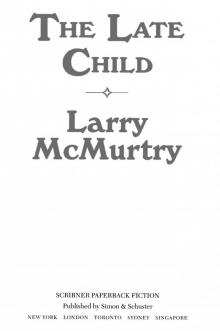 The Late Child
The Late Child Texasville
Texasville Rhino Ranch
Rhino Ranch Pretty Boy Floyd
Pretty Boy Floyd Telegraph Days
Telegraph Days The Evening Star
The Evening Star The Last Kind Words Saloon
The Last Kind Words Saloon Buffalo Girls
Buffalo Girls Horseman, Pass By
Horseman, Pass By Boone's Lick
Boone's Lick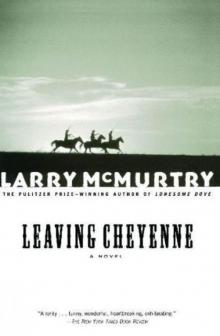 Leaving Cheyenne
Leaving Cheyenne Sin Killer
Sin Killer The Lonesome Dove Chronicles (1-4)
The Lonesome Dove Chronicles (1-4) The Desert Rose
The Desert Rose Moving On
Moving On Dead Man's Walk
Dead Man's Walk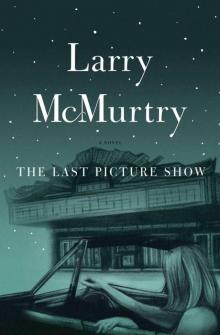 The Last Picture Show
The Last Picture Show When the Light Goes
When the Light Goes Streets Of Laredo ld-2
Streets Of Laredo ld-2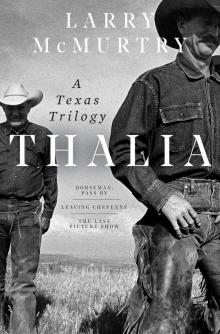 Thalia
Thalia Crazy Horse
Crazy Horse Oh What a Slaughter
Oh What a Slaughter The Colonel and Little Missie
The Colonel and Little Missie Zeke and Ned
Zeke and Ned Telegraph Days: A Novel
Telegraph Days: A Novel The Last Kind Words Saloon: A Novel
The Last Kind Words Saloon: A Novel Comanche Moon ld-4
Comanche Moon ld-4 The Berrybender Narratives
The Berrybender Narratives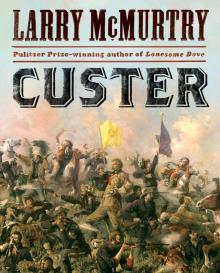 Custer
Custer